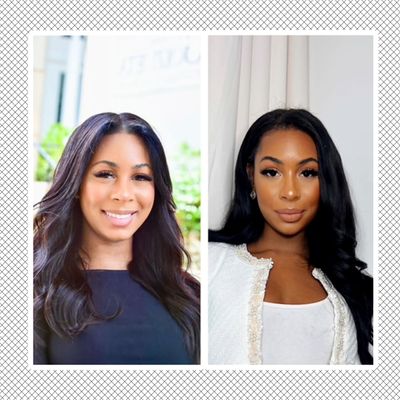
Early this year, procedures like buccal-fat removal that offer a more chiseled or defined facial appearance gained traction, and since then the quest for the most snatched jawline has remained as popular as ever. The latest phenomenon in aesthetics trending on social media: facial balancing.
What Is Facial Balancing?
Naturally, most faces have asymmetries like a slightly bigger eye or a more dropped brow. Most people probably don’t even notice these asymmetries, but for plastic surgeons and nurse practitioners, this presents an opportunity. “It’s aesthetically creating balance and harmony by measuring where and how facial features fall on the face and placing filler in the desired areas to create a balance,” explains Dr. Glenicia Nosworthy, MD., a Brooklyn-based specialist in nonsurgical facial optimization. The procedure is customized for each, as facial features vary. So instead of enhancing one area — for example, the lips — facial balancing means adding small amounts of filler and Botox to various points in the face to give it an overall slightly different look.
How Do Our Faces Become … Unbalanced?
Facial symmetry can be natural or affected by various factors, such as the side of the face we sleep on, the alignment of our teeth, and their impact on our jawline. “You can actually fix a lot of profile balancing with Invisalign and/or braces,” says Nosworthy, noting that she typically refers patients to a collaborating orthodontist if they require facial balancing on the lower third of their face, spanning from the upper lip to the jawline. Regarding other factors such as sleeping habits, Nosworthy points to the fat pads in the cheek area, which can frequently contribute to a loss of facial symmetry. “When I’m assessing a patient, I can actually look at them and tell what side they sleep on based on which fat pad is flatter than the other and that’s just about repeated pressure on one area over a number of years, and it’s a cumulative effect,” she says. Other lifestyle factors, including aging and genetics, can also play a role, but it’s a relatively common occurrence.
Why Is Everyone Wanting Facial Balancing Now?
The short answer is social media. Facial balancing before-and-afters have become a common currency for many dermatologists and plastic surgeons, showing how someone can look different but still maintain the shape of their features. With people constantly taking photos and critiquing themselves, they’re becoming more hung up on the small things like the way their nose could’ve been slightly smaller or the way their jawline could’ve been slightly more snatched. What photo-editing apps do, facial balancing does better. Content creator Jaz Turner went viral on TikTok after showing her facial-balancing results, describing the outcome as “every side becoming her good side in photos.” Turner, initially interested in jawline filler, was introduced to facial balancing for the first time by her injector at a MedSpa she was partnering with. “She explained to me that if I got a little cheek, chin, and jawline filler, it would balance out my face,” Turner says.
According to an American Society of Plastic Surgeons 2022 report, when we stopped wearing masks post-pandemic, surgeons saw a rise in surgeries like lip augmentations, a rise that might be attributed to social media. Injectors “always had a goal of creating symmetry within the face, but the term facial balancing has circulated a lot more, and I think that has a lot to do with social media,” Nosworthy says. Perhaps it’s a way for patients who’ve always wanted filler or enhancements to finally be able to identify what they want.
While some of her commenters caution Turner, who is 26, against undergoing such procedures at a young age, she does not regret her decision to try facial balancing. “I’m so happy and satisfied with my results. I don’t care if they double the price — I’m never letting it go,” she declares. The cost of the procedure varies, ranging from $800 to $3,500, depending on the injectables, which are tailored to each patient’s unique facial features. Results typically last up to 18 months. A number of other patients who have posted their facial-balancing results on social media echo her sentiments: The procedure is indeed worth it. It seems that sometimes subtle tweaks are all that’s needed to make a noticeable difference. Could 2024 be the year we embrace less is more in aesthetics? From the dissolving of surgeries like BBLs and lip fillers to celebrities expressing regrets about certain surgeries there’s a growing awareness that less intervention might be the new trend in aesthetics.





